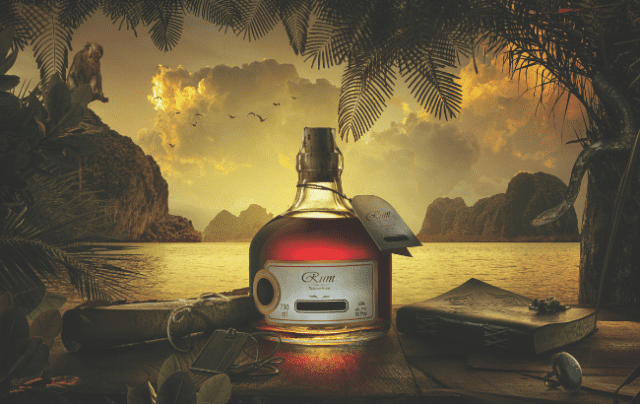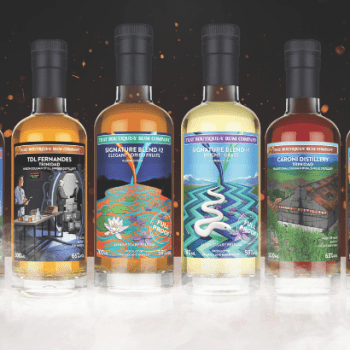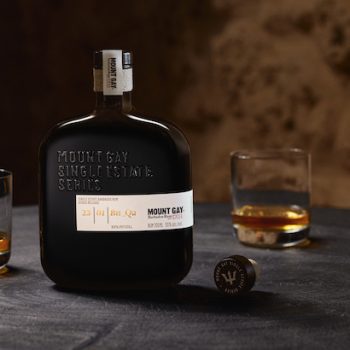Could independent bottlers transform rum?
With their focus on rare, quality expressions from around the world, independent bottlers could transform rum in the way they have whisky, writes Lauren Eads.

*This feature was originally published in the September 2024 issue of The Spirits Business magazine.
Independent bottlers and blenders have long been a part of rum, but never has their influence been more keenly felt. With rum on the rise, the number of these third-party players is growing. Independent bottlers are keen to experiment with rum by sourcing rare casks in limited quantities, while big blenders are more in demand than ever. But what do independent bottlers and blenders bring to the wider rum category? Will their growth support the wider rum category and its mission to become a premium sipping spirit? Or will it be a case of too much, too fast?
For Peter Holland, rum expert and Foursquare Distillery’s UK brand ambassador, the aim was never for rum to be the next big thing. “You don’t want it to be a bubble, to grow and grow then burst,” he says. “We want a nice steady increase, and that’s what’s been happening. But people are picking up on it, and there are going to be a lot of independent bottlers coming to market. They’re not going to realise that it doesn’t matter how good your product is or how nice it looks. It’s getting in front of people – that’s the toughest part.”
While rum has long teetered on the verge of greatness, predictions of a ‘rum boom’ have at times felt overblown, though not without merit. In 2022, sales of rum in the UK on-trade surpassed £1 billion (US$1.2bn), gaining a bigger market share than whisky, according to CGA by NIQ. In 2023, it retained its lead over its brown liquid rival for a second year, encouraging further investment in the category by startups and existing distilleries, including some Scotch whisky bottlers and distilleries. Kill Devil (owned by Scotch bottler Hunter Laing), Gordon & MacPhail, Duncan Taylor, and the Scotch Malt Whisky Society all bottle rums alongside their larger whisky businesses. “The rise of Scotch indie bottlers doing rum lines is definitely opening up a new market to the rum world because more whisky drinkers will be tempted to try them if they trust that specific bottler,” says Dawn Davies, Specialty Drinks’ head buyer. “However, the sheer number of people now doing independent bottlings of rum using poor-quality liquid has the potential to do the opposite, so we need to be careful not to dilute the category.”

The industry should be cautious about maintaining quality, but one thing independent bottlers do extremely well is raising the diversity and accessibility of certain rums. Joe Wilson, head curator and spirits specialist at Rum Auctioneer, says: “Independent bottlers have done a great job of showcasing what has often been the hidden world of rum and making certain unblended spirits available to connoisseurs and enthusiasts. Jamaican distilleries such as Long Pond and New Yarmouth, for example, have only ever contributed rum to marquee blends such as Captain Morgan or Wray & Nephew, but have been spotlighted in recent years through independent cask sales.”
The success of Long Pond and Hampden Estate in particular has led to official distillery bottlings being released for the first time.
Driving force
In the UK, That Boutique-y Rum Company has been a driving force of lesser-known producers, championing a pot still rum from the O Reizinho Distillery in Madeira, and another from the Issan Distillery in Thailand, among others. “[Our] philosophy is about untouched spirits from interesting distilleries and bringing to the world ‘pure rum’, says Dave Worthington, global brand ambassador at That Boutique-y Rum Company. “We find forgotten casks, bottles from long-closed distilleries, and bring forth unusual rums that might otherwise not have seen the light of day.”
While these bottles are dearer than the norm, their success is helping to shed the image that rum should be cheap, supporting a rise in rum’s value. Lisa Halstead, buyer at spirits retailer Master of Malt, reported a “significant rise” in sales of premium rum. Bottles priced over £100 accounted for 14% of total rum sales in 2023, up from 9% in 2022. IWSR’s latest global figures support this, predicting the value of premium rums will grow by a compound annual growth rate of 2% for 2023-28, and by 3% for super-premium rums, outpacing global rum at 1%. “By providing a more diverse marketplace for rum, independent bottlers have emboldened some of the bigger drinks companies to pursue ultra-premium brands,” adds Wilson.
It’s wrong to assume that bulk blenders only represent low-quality liquid. Rum brokers and blenders source spirits from multiple distilleries and sell it on to independent bottlers and private labels that often need larger quantities to ensure a consistent product line, from entry-level to super-premium. “Both are essential to the overall health and diversity of the rum industry,” adds Worthington.
Their stocks are vast, as is their power to support distilleries worldwide, and a huge part of their business deals in smoothing out logistics and imports. There are also many distilleries whose entire model is based on selling in bulk. “Hampden Estate, for example, wouldn’t exist if it weren’t selling bulk,” adds Holland. “Luca [Gargano] at Velier has really made all the difference to it. Without E&A Scheer, private-label supermarket bottles wouldn’t exist, and the things that we take for granted just wouldn’t be there.”
Not all bulk blended rum is especially interesting or complex, but it is fundamental to the rum category. This year Amsterdam-based E&A Scheer, the world’s biggest bulk blender of premium rum – which also owns Main Rum, the Liverpool-based supplier of rare, single-barrel rums – was sold to financial investor Platinum Equity. What could this mean for the market? Wilson says: “E&A Scheer has a sizeable monopoly on the rum cask trade and bulk sales of blends, so it is ideally placed to profit from the market of an emerging spirits market either through the status quo or if it is looking to build its own in-house portfolio of brands.”
But Carsten Vlierboom, chief rum officer at E&A Scheer, says its approach will not change: “The strategy of E&A Scheer remains to make bulk rum sourcing easy, for many small and large international customers who find our blends and quick turnaround very efficient for their rum brands.”

Transparency is also key if consumers are to trust independent bottlers (which are less familiar to them than whisky bottlers), over big brands. A lack of information on where a rum is aged can feed distrust. While most independent bottlers and blenders strive to provide many details, and are responding to growing demand for greater transparency about the production, maturation, and age of rums in a blend, it’s not always possible to reveal the distillery that made it.
“Through our relations with distilleries we have agreements in place on the use or non-use of trademarks, distillery name and so forth, thus protecting the IP of our partners, but transparency and sharing of knowledge on the rums in rum blends, in our opinion, is great,” says Vlierboom.
Legal requirements
The issue lies more at the cheaper end of the market, says David Howarth, brand owner at Manchester’s House of Rum, which was founded in 2023, and bottles single cask, single vintage expressions. “You have ‘rums’ on the market that aren’t technically rums because they don’t meet the legal requirement of containing at least 37.5% ABV,” he says. “This is an issue for the category, as rum needs to break out of this smoke-and-mirrors approach, and the perception of ‘cheapness’. Only by providing transparency will consumers begin to understand the authenticity of the liquid, and understand the various price points.”
For Howarth, there are two directions rum could take: bottlers and blenders seeking to “replicate the gin boom”, leaning into flavoured and spiced rums for mixing; and those, like his, that are offering more premium rare blends and aged rums. Most independent bottlers favour the latter, and have set out to buy and sell great rum, capturing the attention of a niche but dedicated set of connoisseurs.
As Wilson notes: “In general, the rum market has followed a similar trend to that of Scotch whisky in the 1980s, where almost all of the market was dominated by blends until independent bottlers and pioneering single malt brands bucked the trend and created a new market for the single-distillery category.” Similarly, it was the “cult indie bottlers in whisky” that made certain distilleries famous, adds Davies.
Could this happen in rum? “As long as the quality level is kept high, and the market is not flooded, which I feel at the moment there is a danger of happening. It’s about looking for those that do it well – people like Holmes Cay, Single Barrel Selection, and Habitation Velier – and doing your research to make sure you are paying the right price for the right quality,” she says.
There’s a way to go before rum is on par with whisky, if that’s even the aim, but it’s not impossible. That alone is a big step forward for a spirit once confined to a little more than a Cuba Libre.
How do you educate consumers about your rum production process and the importance of transparency?

Bernard d’Offay – co-founder, Takamaka
“A key part of education is about providing the information that allows people to make a choice. So, for us, transparency about our rum making and education go absolutely hand in hand. Late in 2019 we made the conscious decision to be truly open. Our rum recipes are printed on the front of the bottle, we are one of the few rum brands that always highlight if any colouring or sugar has been added, and as we started to use technology to innovate – we put it front and centre on the label. We took it a step further by breaking down the blend components on each of our rums, and sharing that clearly on our website.”
Roy Kristoffer Sumang – international business development manager, Tanduay Rum
“Tanduay conducts masterclasses, and we produce videos and other content explaining our company, our brands, our process, even our sustainability efforts. And we share these materials with all our partners. We also do truthful advertising; we only share what our product is, and do not overstate what we are not. We adhere to market compliances by submitting all regulatory information as required by the government. We value transparency in the highest regard. We don’t hide anything from the people we cater to. That’s why Tanduay has been applying for various accreditations, like GMP and ISO 9001:2015, to ensure that all our practices are well within industry standards.”
Chiara Pennacchio – global marketing director, Ron Barceló
“We are committed to educating consumers and the media about the different types of rums according to their raw material, distillation methods, ageing processes, and varieties of organoleptic profiles under a robust 360⁰ training plan that includes masterclasses by our brand ambassadors around the world, communication plans through print and digital media to make knowhow accessible, and our most recent approach to consumers, which is our digital educational platform for YouTube, Barceló Rum Academy. The premiumisation of rum is a reality, and its differentiation bases are worth sharing.”
Angélique Jullienne – global marketing and communication director, Maison Ferrand
“Education is in our DNA. We love sharing with both the trade and consumers how we craft our rums, in the most transparent way possible. Our core values are community – because we believe that connecting and sharing make the journey more rewarding – and education, because understanding what’s in your glass enhances your appreciation of it. Planteray became the first rum brand to fully disclose all details on labels, including information about distillation, fermentation, and dosage. We want our customers to know exactly what’s in their bottle. Our team also shares knowledge through hundreds of seminars, masterclasses, and tastings each year.”

Antoine Couvreur – managing director, Mount Gay
“With over 321 years of rum-making heritage in Barbados, Mount Gay is passionate about education. As the world’s oldest continuously running rum distillery, our site is open for daily tours, led by Bajan rum experts. Guests discover the history and production of rum, and enjoy a tasting of our finest blends. Last year we took transparency of our rum-making process to a new level with the launch of Single Estate Series. Our first rum to be released from sugarcane grown on our very own estate allowed us to offer consumers full transparency from soil to sip. Bottles feature a QR code for a webpage with every detail, from the sugarcane cultivars to the person who distilled their rum.”
Mauricio Solórzano – senior ambassador, Flor de Caña
“We prioritise educating our consumers by openly sharing our brand’s 135-year story, our unique natural ageing process, and our historic commitment to sustainable practices. Another key aspect is offering immersive and intimate interactions with our rum, such as tastings, pairings and five-sense experiences, where they can witness first-hand the craftsmanship, quality and sustainability behind our liquid. As a single-estate rum, we believe consumers value understanding our production process, from field to bottle, as it highlights the care and integrity behind every bottle. By sharing this journey, we not only educate but also foster trust and a deeper appreciation for the quality and authenticity of our rum.”
Manuel Villa – founder and CEO, Qantima Group
“Transparency in the production of Cab-Ron is key to gaining the trust of consumers, and standing out in a competitive market. We share all the details about the ingredients, processes, and history of the brand, build stronger relationships with our customers, and foster a culture of rum appreciation. The benefits of transparency include greater customer loyalty, better relationships with distributors, and greater visibility in the market. For this reason, Cab-Ron allocates part of the profits obtained from its sale to the Pasqual Maragall Foundation [which researches Alzheimer’s disease]. To be truly transparent, a brand must communicate its story, be honest with the ingredients, detail the production process, show a clear social commitment and environmental sustainability.”
Victor Vernet – international brand manager, rhum, La Martiniquaise-Bardinet
“At Saint James Rhum, we believe that educating consumers is key to appreciating the craftsmanship behind agricole rhums, Martinique’s best-kept jewel. We prioritise transparency by showcasing our production process, from sugarcane fields through cellars to bottle, providing immersive distillery tours and digital content. As agricole rhums, made from pure cane juice, have such a different organoleptic profile than traditional rums using molasses, liquid to lips is key for us. Therefore, we also engage in educational tastings and masterclasses, where we delve into the importance of our agricole rhum’s origins and sustainable practices.”
Related news
